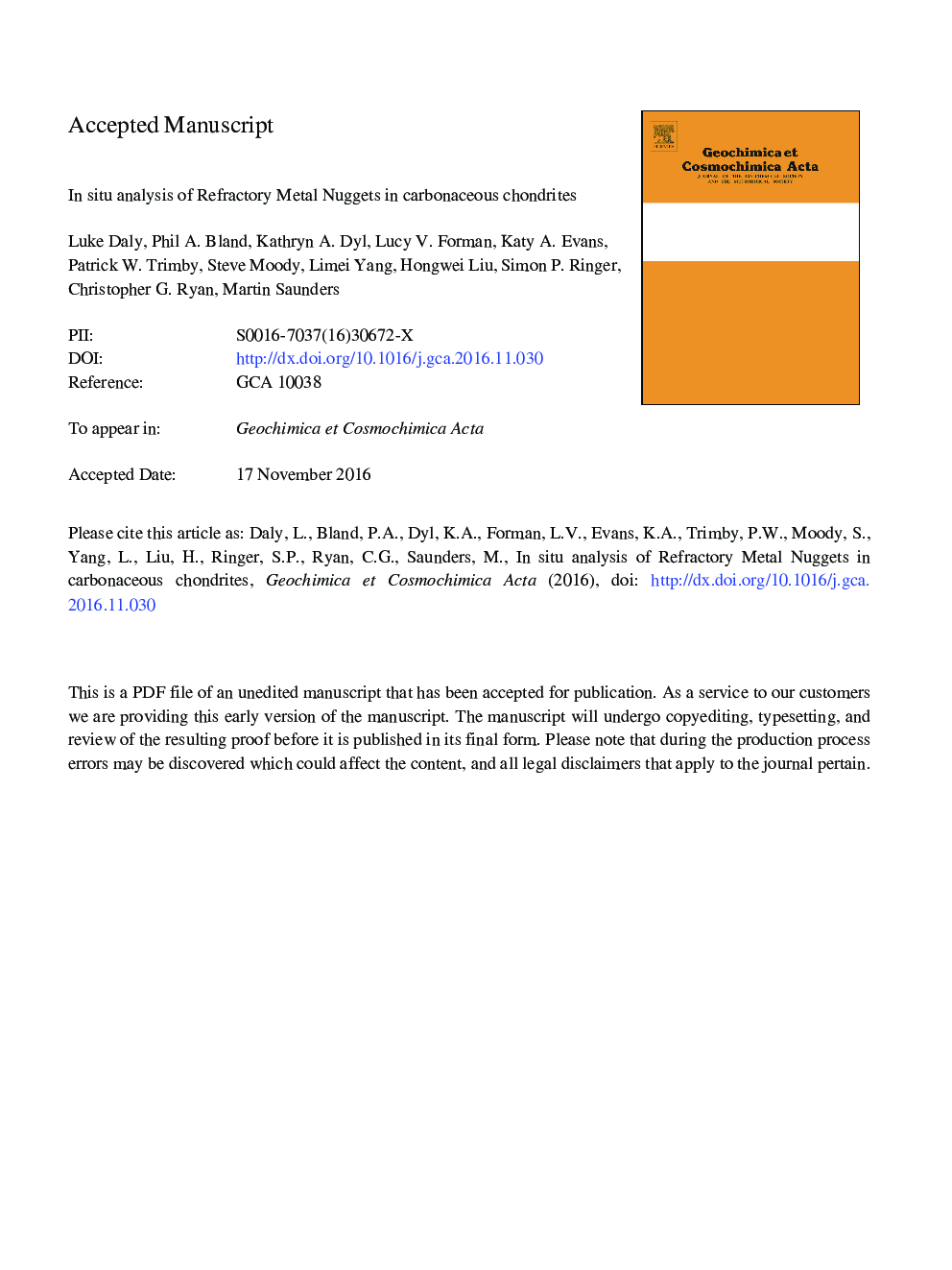| کد مقاله | کد نشریه | سال انتشار | مقاله انگلیسی | نسخه تمام متن |
|---|---|---|---|---|
| 5783109 | 1637941 | 2017 | 39 صفحه PDF | دانلود رایگان |
عنوان انگلیسی مقاله ISI
In situ analysis of Refractory Metal Nuggets in carbonaceous chondrites
ترجمه فارسی عنوان
تجزیه و تحلیل موضعی فلزات نسوز در کاندیدای کربن
دانلود مقاله + سفارش ترجمه
دانلود مقاله ISI انگلیسی
رایگان برای ایرانیان
کلمات کلیدی
فلزات نسوز، سحابی خورشیدی، منظومه شمسی، اصل و نسب، شهاب سنگها، کاندیدای کربنی،
موضوعات مرتبط
مهندسی و علوم پایه
علوم زمین و سیارات
ژئوشیمی و پترولوژی
چکیده انگلیسی
Micrometre to sub-micrometre-scale alloys of platinum group elements (PGEs) known as Refractory Metal Nuggets (RMNs) have been observed in primitive meteorites. The Australian Synchrotron X-ray Fluorescence (XRF) beamline, in tandem with the Maia detector, allows rapid detection of PGEs in concentrations as low as 50-100 ppm at 2 μm resolution. Corroborating these analyses with traditional electron microscopy techniques, RMNs can be rapidly identified in situ within carbonaceous chondrites. These results dispute the assumption of most previous studies: that RMNs are unique to Ca-Al-rich inclusions (CAIs). We find that RMNs are, in fact, observed within all components of carbonaceous chondrites, such as the matrix, chondrules (consistent with observations from Schwander et al. (2015b) and Wang et al. (2007)), and sulphides; though the majority of RMNs are still found in CAIs. The chemistry of RMNs reveals a complex diversity of compositions, which nevertheless averages to CI chondrite abundance ratios. This implies that RMNs are the dominant, if not sole host phase for PGEs. One hundred and thirteen RMNs from this study are combined with reported compositions in the literature, and compared to condensation model compositions similar to Berg et al. (2009), RMNs derived experimentally by precipitation (Schwander et al., 2015a), host phase and host meteorite. Comparisons reveal only weak correlations between parent body processes (sulphidation) and nebular processes (condensation and precipitation) with RMN compositions. It appears that none of these processes acting in isolation or in tandem can explain the diversity observed in the RMN population. Our interpretation is that the Solar Nebula inherited an initially compositionally diverse population of RMNs from the Giant Molecular Cloud; that a variety of Solar System processes have acted on that population; but none have completely homogenised it. Most RMNs have experienced disk and asteroidal processing, but some may have retained a primordial composition. RMNs have been identified in pre-solar graphite grains (Croat et al., 2013). We anticipate that pre-solar RMNs will be present elsewhere in primitive meteorites.
ناشر
Database: Elsevier - ScienceDirect (ساینس دایرکت)
Journal: Geochimica et Cosmochimica Acta - Volume 216, 1 November 2017, Pages 61-81
Journal: Geochimica et Cosmochimica Acta - Volume 216, 1 November 2017, Pages 61-81
نویسندگان
Luke Daly, Phil A. Bland, Kathryn A. Dyl, Lucy V. Forman, Katy A. Evans, Patrick W. Trimby, Steve Moody, Limei Yang, Hongwei Liu, Simon P. Ringer, Christopher G. Ryan, Martin Saunders,
